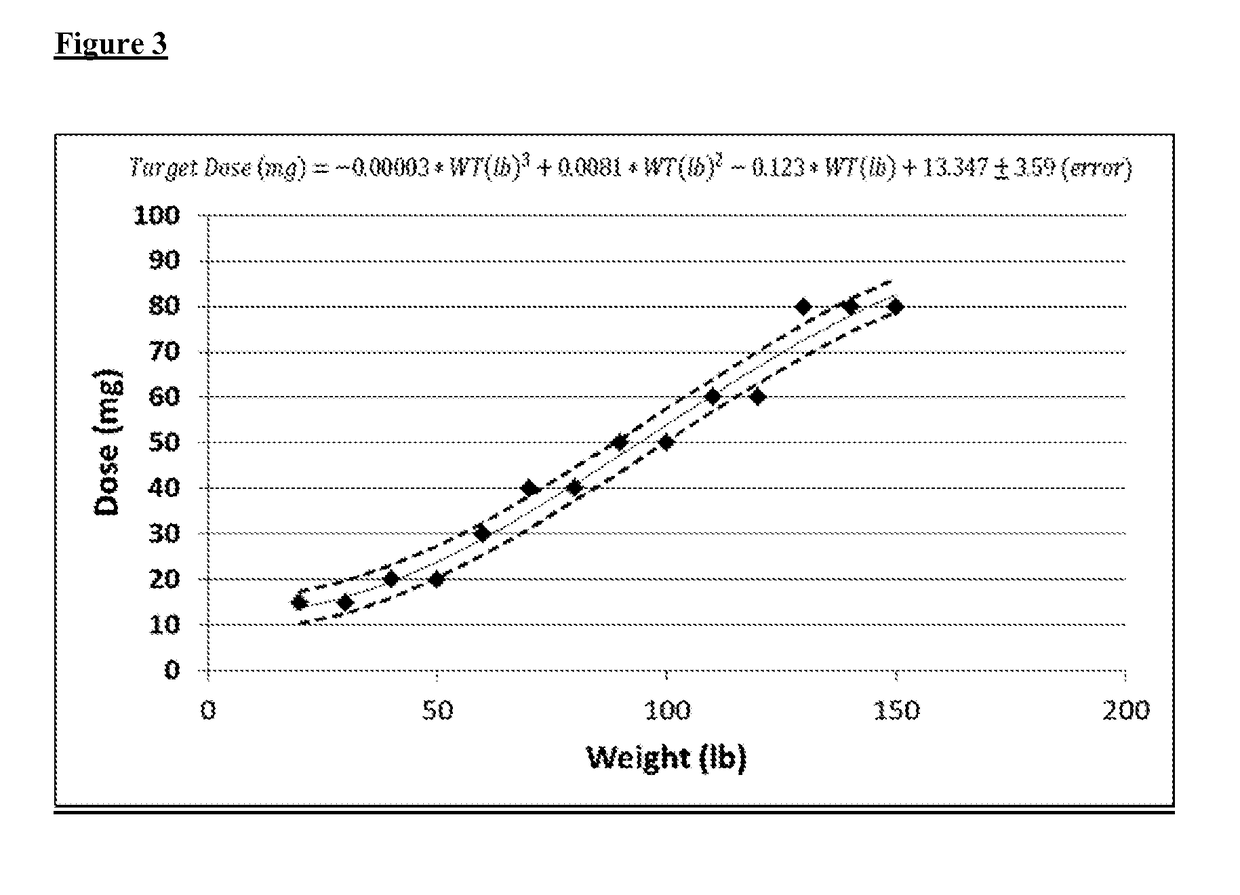Methods for treating attention deficit hyperactivity disorder with methylphenidate
a technology of methylphenidate and hyperactivity disorder, which is applied in the field of methods of treating attention deficit hyperactivity disorder, can solve the problems of patients receiving suboptimal treatment, patients abandoning treatment all together, and patients unable to meet the requirements of treatment, so as to reduce or eliminate the titration period
- Summary
- Abstract
- Description
- Claims
- Application Information
AI Technical Summary
Benefits of technology
Problems solved by technology
Method used
Image
Examples
example 1
Pharmacokinetics Model in Adults
[0062]A base pharmacokinetics model (Base PK model) was established using the two-parallel input model with elimination from a single compartment, fit to the concentration-time data from the Single Dose Study in Adults using the first-order conditional estimation with interaction method in Phoenix NLME. The final model consists of 6 parameters: F1 represents the fraction of dose in the immediate release layer, Ka1 represents the first-order absorption rate for methylphenidate in the immediate release layer, Ka2 represents the first-order absorption rate for methylphenidate in the extended release layer, tlag represents the lag time for methylphenidate in the extended release layer, CL represents the apparent plasma clearance of methylphenidate, and V represents the apparent volume of distribution of methylphenidate. Between individual variability parameters were included on Ka1, Ka2, CL, and V. The proportional residual error model was superior to the...
example 2
Pharmacokinetics Model in Pediatric Patients
[0065]A model similar to the Base PK model was established using the same two-input, 1-compartment, 1st order elimination model based on the data collected from the Pediatric and Adolescent Pharmacokinetic Study. The pediatric PK model was consistent with the Base PK model. In addition, the potential effects of body weight, height and body mass index on the PK of methylphenidate in pediatric patients were evaluated using a stepwise addition and deletion method. Each covariate was evaluated for its potential impact on the volume of distribution, clearance, and lag time parameters of the population pharmacokinetic model. The final model included body weight as a covariate of methylphenidate clearance as shown in Equation 1:
CLi=CLTV*WTθeηjCL Equation 1:[0066]where:[0067]CLi=the true clearance for individual i[0068]CLTV=the typical value (population mean) for clearance[0069]WT=body weight for individual i[0070]θ=Effect of body weight on clear...
example 3
[0076]The dose needed to achieve an 18-point reduction in total ADHD score for a patient in need of treatment can be determined from the body weight of the patient in pounds. Based on the human adult and pediatric studies described above and the simulation in Example 2, the dose or range of doses required to achieve an 18 point target reduction in total ADHD score can be plotted against the body weight of the patient, and the data can be fit to a 3rd order polynomial equation for each body weight measurement in pounds as shown in FIG. 3. The amount of methylphenidate in milligrams for a given patient body weight can be determined using the following equation:
Dose (mg)=−0.00003*WT (lb)3+0.0081*WT (lb)2−0.123*WT (lb)+13.347±3.59
wherein WT is the patient body weight in pounds.
[0077]For patients of particular weights, the ranges of dose amounts determined based on body weight are shown in Table 4. Such determinations are exemplary embodiments of the invention.
TABLE 4wt (lbs)low (mg)high...
PUM
| Property | Measurement | Unit |
|---|---|---|
| body weight | aaaaa | aaaaa |
| body weight | aaaaa | aaaaa |
| attention deficit hyperactivity disorder | aaaaa | aaaaa |
Abstract
Description
Claims
Application Information
 Login to View More
Login to View More - R&D
- Intellectual Property
- Life Sciences
- Materials
- Tech Scout
- Unparalleled Data Quality
- Higher Quality Content
- 60% Fewer Hallucinations
Browse by: Latest US Patents, China's latest patents, Technical Efficacy Thesaurus, Application Domain, Technology Topic, Popular Technical Reports.
© 2025 PatSnap. All rights reserved.Legal|Privacy policy|Modern Slavery Act Transparency Statement|Sitemap|About US| Contact US: help@patsnap.com


